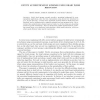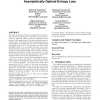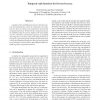77 search results - page 13 / 16 » Communication-Efficient Group Key Agreement |
DAM
2006
13 years 7 months ago
2006
Abstract. Artin's braid groups currently provide a promising background for cryptographical applications, since the first cryptosystems using braids were introduced in [2, 3, ...
CORR
2006
Springer
13 years 7 months ago
2006
Springer
Let G1 be a cyclic multiplicative group of order n. It is known that the Diffie-Hellman problem is random self-reducible in G1 with respect to a fixed generator g if (n) is known....
STOC
2010
ACM
13 years 11 months ago
2010
ACM
We study the problem of "privacy amplification": key agreement between two parties who both know a weak secret w, such as a password. (Such a setting is ubiquitous on th...
CSFW
2005
IEEE
14 years 1 months ago
2005
IEEE
A number of key establishment protocols claim the property of forward secrecy, where the compromise of a longterm key does not result in the compromise of previously computed sess...
CTRSA
2010
Springer
13 years 11 months ago
2010
Springer
This paper presents a new identity based key agreement protocol. In id-based cryptography (introduced by Adi Shamir in [33]) each party uses its own identity as public key and rece...



